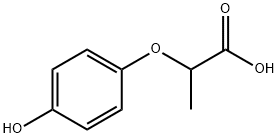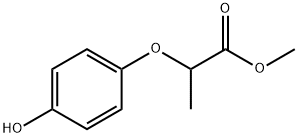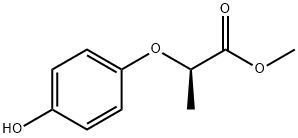2-(4-HYDROXYPHENOXY)PROPIONIC ACID
- CAS NO.:67648-61-7
- Empirical Formula: C9H10O4
- Molecular Weight: 182.17
- MDL number: MFCD00012181
- SAFETY DATA SHEET (SDS)
- Update Date: 2023-04-23 13:52:06

What is 2-(4-HYDROXYPHENOXY)PROPIONIC ACID?
Chemical properties
white to light beige crystalline powder
The Uses of 2-(4-HYDROXYPHENOXY)PROPIONIC ACID
2-(4-Hydroxyphenoxy)propanoic Acid is a component in a cosmetic formulation including fatty acids, which has skin-lightening properties. 2-(4-Hydroxyphenoxy)propanoic Acid is also used in another cosmetic formulation, which gives rise to the reduction of signs of skin aging, wrinkles and UV damaged skin when applied topically.
Properties of 2-(4-HYDROXYPHENOXY)PROPIONIC ACID
| Melting point: | 143-146 °C(lit.) |
| Boiling point: | 275.56°C (rough estimate) |
| Density | 1.2481 (rough estimate) |
| refractive index | 1.4345 (estimate) |
| storage temp. | Sealed in dry,Room Temperature |
| solubility | DMSO (Slightly), Methanol (Sparingly) |
| pka | 3.32±0.10(Predicted) |
| form | Solid |
| color | Pale Brown to Light Brown |
| CAS DataBase Reference | 67648-61-7(CAS DataBase Reference) |
Safety information for 2-(4-HYDROXYPHENOXY)PROPIONIC ACID
| Signal word | Warning |
| Pictogram(s) |
 Exclamation Mark Irritant GHS07 |
| GHS Hazard Statements |
H315:Skin corrosion/irritation H319:Serious eye damage/eye irritation H335:Specific target organ toxicity, single exposure;Respiratory tract irritation |
| Precautionary Statement Codes |
P261:Avoid breathing dust/fume/gas/mist/vapours/spray. P305+P351+P338:IF IN EYES: Rinse cautiously with water for several minutes. Remove contact lenses, if present and easy to do. Continuerinsing. |
Computed Descriptors for 2-(4-HYDROXYPHENOXY)PROPIONIC ACID
New Products
Tert-butyl bis(2-chloroethyl)carbamate (S)-3-Aminobutanenitrile hydrochloride N-Boc-D-alaninol N-BOC-D/L-ALANINOL N-octanoyl benzotriazole 3-Morpholino-1-(4-nitrophenyl)-5,6-dihydropyridin- 2(1H)-one Furan-2,5-Dicarboxylic Acid Tropic acid Fmoc-Val-Cit-PAB DIETHYL AMINOMALONATE HYDROCHLORIDE 1,1’-CARBONYLDIIMIDAZOLE R-2-BENZYLOXY PROPIONIC ACID 1,1’-CARBONYLDI (1,2-4 TRIAZOLE) N-METHYL INDAZOLE-3-CARBOXYLIC ACID (2-Hydroxyphenyl)acetonitrile 4-Bromopyrazole 5-BROMO-2CYANO PYRIDINE 5-broMo-2-chloro-N-cyclopentylpyriMidin-4-aMine 2-(Cyanocyclohexyl)acetic acid 4-methoxy-3,5-dinitropyridine 2-aminopropyl benzoate hydrochloride 1-(4-(aminomethyl)benzyl)urea hydrochloride tert-butyl 4- (ureidomethyl)benzylcarbamate diethyl 2-(2-((tertbutoxycarbonyl)amino) ethyl)malonateRelated products of tetrahydrofuran






![DL-2-[4-(TRIFLUOROMETHOXY)PHENOXY]PROPIONIC ACID](https://img.chemicalbook.in/CAS/GIF/175204-35-0.gif)

You may like
-
 2033-24-1 98%View Details
2033-24-1 98%View Details
2033-24-1 -
 1975-50-4 98%View Details
1975-50-4 98%View Details
1975-50-4 -
 2-HYDROXY BENZYL ALCOHOL 98%View Details
2-HYDROXY BENZYL ALCOHOL 98%View Details
90-01-7 -
 2-Chloro-1,3-Bis(Dimethylamino)Trimethinium Hexafluorophosphate 221615-75-4 98%View Details
2-Chloro-1,3-Bis(Dimethylamino)Trimethinium Hexafluorophosphate 221615-75-4 98%View Details
221615-75-4 -
 61397-56-6 CIS BROMO BENZOATE 98%View Details
61397-56-6 CIS BROMO BENZOATE 98%View Details
61397-56-6 -
 14714-50-2 (2-Hydroxyphenyl)acetonitrile 98+View Details
14714-50-2 (2-Hydroxyphenyl)acetonitrile 98+View Details
14714-50-2 -
 118753-70-1 98+View Details
118753-70-1 98+View Details
118753-70-1 -
 733039-20-8 5-broMo-2-chloro-N-cyclopentylpyriMidin-4-aMine 98+View Details
733039-20-8 5-broMo-2-chloro-N-cyclopentylpyriMidin-4-aMine 98+View Details
733039-20-8
Statement: All products displayed on this website are only used for non medical purposes such as industrial applications or scientific research, and cannot be used for clinical diagnosis or treatment of humans or animals. They are not medicinal or edible.